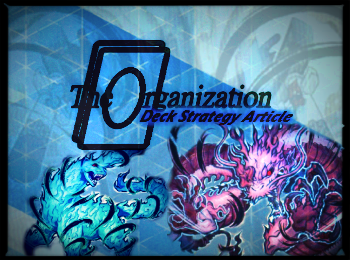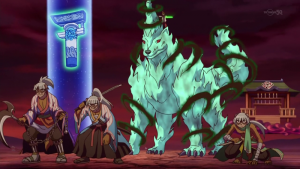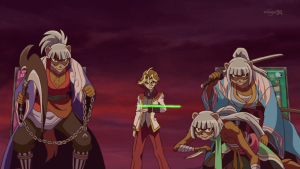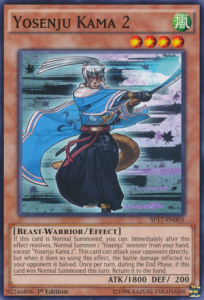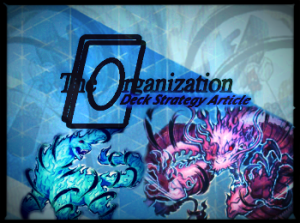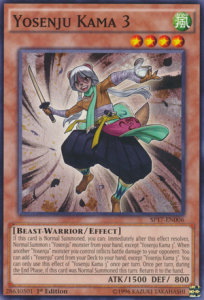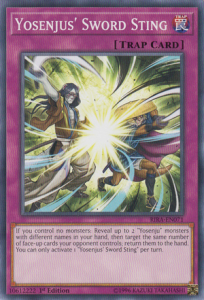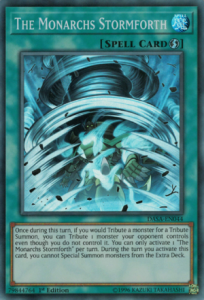Blow through the field with the power of the Wind Weasels!
Introduction:
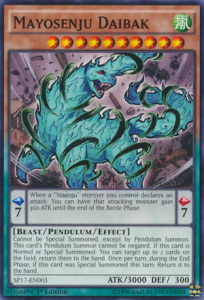 The Yosenju archetype really needs no introduction. Storming into the game straight from the Arc V anime, this Spirit Samurai archetype brings the fury of WIND monsters on a rampage with flurries of Normal Summons and endless spinning. With the release of Rising Rampage in the TCG recently, this theme got a batch of new support cards that seemed like they would offer a second wind to this archetype, so let’s explore how we can use these new cards to breeze some life back into this beloved strategy. But when the Yosenju support cards were first revealed for RIRA, the immediate reaction was happiness followed by a deep sadness, especially for those that had ignored the Pendulum core of the deck.
The Yosenju archetype really needs no introduction. Storming into the game straight from the Arc V anime, this Spirit Samurai archetype brings the fury of WIND monsters on a rampage with flurries of Normal Summons and endless spinning. With the release of Rising Rampage in the TCG recently, this theme got a batch of new support cards that seemed like they would offer a second wind to this archetype, so let’s explore how we can use these new cards to breeze some life back into this beloved strategy. But when the Yosenju support cards were first revealed for RIRA, the immediate reaction was happiness followed by a deep sadness, especially for those that had ignored the Pendulum core of the deck.
Historically, the Yosenju archetype had been stuck between two worlds. With half the support clearly geared towards Pendulum Summoning and the other half able to function without it, this archetype appeared at first glance to have a lack of focus. But let me present a different take on the new support – for the first time, the two styles got neatly stitched together. For the first time they didn’t have to just be a stun engine with some swarming potential, they could actually begin to utilize their beast of a boss monster, Mayosenju Daibak. By the end of this article, hopefully you see how this is the case.
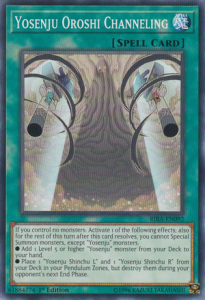 The biggest new addition for the theme was consistent ways to setup their Pendulum engine without losing card advantage, and that came with the TCG import of Yosenju Oroshi Channeling, a spell that either sets up their scales for a +1 or that can add one of your higher leveled Yosenju to hand. Sure, this may lock you down to only Special Summoning Yosenju monsters for the turn, but that isn’t too much of a restriction when paired with other similar effects. Also, the dual nature of this effect lends itself to support a variety of hands you might encounter. One less favorable to Pendulum Summoning can just choose the other route. The last major unique quality of the deck is its ability to return cards your opponent controls to the hand, with such a wide variety of effects. So let’s dive into how this hybrid Yosenju strategy will function with the new support.
The biggest new addition for the theme was consistent ways to setup their Pendulum engine without losing card advantage, and that came with the TCG import of Yosenju Oroshi Channeling, a spell that either sets up their scales for a +1 or that can add one of your higher leveled Yosenju to hand. Sure, this may lock you down to only Special Summoning Yosenju monsters for the turn, but that isn’t too much of a restriction when paired with other similar effects. Also, the dual nature of this effect lends itself to support a variety of hands you might encounter. One less favorable to Pendulum Summoning can just choose the other route. The last major unique quality of the deck is its ability to return cards your opponent controls to the hand, with such a wide variety of effects. So let’s dive into how this hybrid Yosenju strategy will function with the new support.
Strategy:
 In the modern game, the Yosenju strategy boils down to a non-conventional approach to a Pendulum theme. The first is that your goal is to use your Pendulum Summon for one monster. The second is that your goal is to not have to Pendulum Summon on your first turn. Many Pendulum strategies nowadays rely upon that initial flurry of summons alongside a Heavymetalfoes Electrumite to generate advantage and get their game rolling. Yosenju on the other hand, tend to use their Pendulum Summon to clear the way for their real play to go forth unencumbered. To support this goal, Yosenju Sabu is called into the fray to get the Pendulums you need. At the end of your Kama summon chains, bring him out to search any Yosenju Pendulum, this will give you the windpower to go for that Pendulum summon for your second wave of attacks.
In the modern game, the Yosenju strategy boils down to a non-conventional approach to a Pendulum theme. The first is that your goal is to use your Pendulum Summon for one monster. The second is that your goal is to not have to Pendulum Summon on your first turn. Many Pendulum strategies nowadays rely upon that initial flurry of summons alongside a Heavymetalfoes Electrumite to generate advantage and get their game rolling. Yosenju on the other hand, tend to use their Pendulum Summon to clear the way for their real play to go forth unencumbered. To support this goal, Yosenju Sabu is called into the fray to get the Pendulums you need. At the end of your Kama summon chains, bring him out to search any Yosenju Pendulum, this will give you the windpower to go for that Pendulum summon for your second wave of attacks.
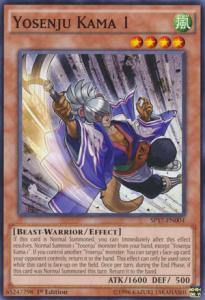 So I can’t discuss Yosenju without talking about the Kamas. Each, when Normal Summoned, lets you immediately normal summon another Yosenju, then they also have an additional effect. Yosenju Kama 1 bounces 1 card your opponent controls to the hand, if you control another Yosenju monster. Yosenju Kama 2 can attack directly, which enables Yosenju Kama 3, which lets you search any Yosenju card whenever another Yosenju inflicts battle damage to the opponent. This combo is the core of your deck, Pendulum summons or not. But which Pendulum monster is our go-to nowadays?
So I can’t discuss Yosenju without talking about the Kamas. Each, when Normal Summoned, lets you immediately normal summon another Yosenju, then they also have an additional effect. Yosenju Kama 1 bounces 1 card your opponent controls to the hand, if you control another Yosenju monster. Yosenju Kama 2 can attack directly, which enables Yosenju Kama 3, which lets you search any Yosenju card whenever another Yosenju inflicts battle damage to the opponent. This combo is the core of your deck, Pendulum summons or not. But which Pendulum monster is our go-to nowadays?
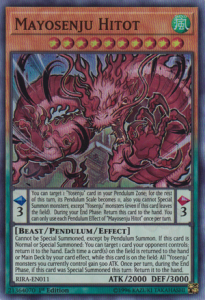 Before, the deck struggled to get the valuable combination of both Shinchu pendulum scales (Yosenju Shinchu R and Yosenju Shinchu L) to meet the threshold to bring out your Daibak. With the entrance of Mayosenju Hitot to the fray, this is no longer a problem. First, he can make any Yosenju pendulum into scale 11 for the turn. This is GREAT, as him plus any other Pendulum is the same result as having the two Shinchus. The other big piece element to Hitot is that it actually returns to hand during the EP like the Kamas, even if it is just in the Pendulum Zone as a Spell. This allows for great synergy with Card of Demise, something the modern version of the deck still abuses.
Before, the deck struggled to get the valuable combination of both Shinchu pendulum scales (Yosenju Shinchu R and Yosenju Shinchu L) to meet the threshold to bring out your Daibak. With the entrance of Mayosenju Hitot to the fray, this is no longer a problem. First, he can make any Yosenju pendulum into scale 11 for the turn. This is GREAT, as him plus any other Pendulum is the same result as having the two Shinchus. The other big piece element to Hitot is that it actually returns to hand during the EP like the Kamas, even if it is just in the Pendulum Zone as a Spell. This allows for great synergy with Card of Demise, something the modern version of the deck still abuses.
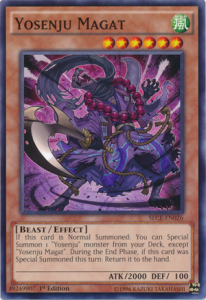 Lastly, let’s talk about the namesake of this article, because The Monarchs Stormforth adds yet another dimension to the deck. Because Oroshi Channeling or the scale change of Hitot locks out your Extra Deck anyways, you might as well take advantage of this with the intheme tribute summoning Yosenju – Yosenju Magat. Magat, when Normal Summoned, lets you Special Summon any other Yosenju to the field. This can bring out the last new monster from RIRA, Yosenju Izna, which carries an ignition effect to draw an extra card. Now, the deck finally has a monster it wants to Special Summon with Magat, making everything come together.
Lastly, let’s talk about the namesake of this article, because The Monarchs Stormforth adds yet another dimension to the deck. Because Oroshi Channeling or the scale change of Hitot locks out your Extra Deck anyways, you might as well take advantage of this with the intheme tribute summoning Yosenju – Yosenju Magat. Magat, when Normal Summoned, lets you Special Summon any other Yosenju to the field. This can bring out the last new monster from RIRA, Yosenju Izna, which carries an ignition effect to draw an extra card. Now, the deck finally has a monster it wants to Special Summon with Magat, making everything come together.
If you still don’t understand how this strategy functions yet and remain unconvinced – that’s completely fine. I’m not finished discussing this archetype yet. So take this pause in my wall of text to check out the decklist, then I’ll continue onwards.
Decklist:
Click to view the Interactive Decklist in the Official Card Database.
Spoiler
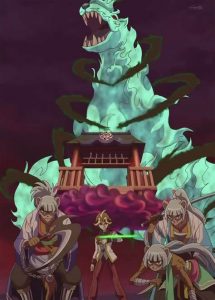 Monsters: 20
Monsters: 20
| Mayosenju Daibak
||| Mayosenju Hitot
||| Yosenju Kama 1
|| Yosenju Kama 2
||| Yosenju Kama 3
|| Yosenju Magat
|| Yosenju Sabu
| Yosenju Inza
|| Yosenju Shinchu L
| Yosenju Shinchu R
Spells: 15
|| Card of Demise
||| Pot of Extravagance
||| Fire Formation – Tenki
||| The Monarchs Stormforth
| Yosen Training Ground
||| Yosenju Oroshi Channeling
Traps: 5
| Dizzying Winds of Yosen Village
|| Yosenjus’ Sword Sting
|| Yosenjus’ Secret Move
Extra: 15
| Abyss Dweller
| Evilswarm Exciton Knight
||| Number 41: Bagooska the Terribly Tired Tapir
| Tornado Dragon
| Borrelsword Dragon
| Greatfly
| Heavymetalfoes Electrumite
| Knightmare Cerberus
| Knightmare Phoenix
| Knightmare Unicorn
| Underclock Taker
| Zefra Metaltron
| Wynn the Wind Charmer, Verdant
Strange Choices? No – Intentional Ones.
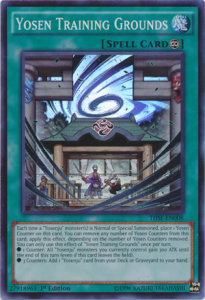 You may be staring at this decklist confused at some of my choices. A lack of Lose 1 Turn, no Yosenju Tsujik, only 1 Yosen Training Grounds, or maybe it’s the fact that I am running The Dizzying Winds of Yosen Village. I get that this all might be confusing. But let me hopefully clear the water on at least these callouts. First, Lose 1 Turn and other similar stun cards are inherently dysfunctional alongside a Pend deck. With limited backrow zones to work with, you need to minimize the continuous spells or traps you run. In this case, I prioritize having extra slots to activate Fire Formation – Tenki over copies of this and other stun cards like Gozen Match.
You may be staring at this decklist confused at some of my choices. A lack of Lose 1 Turn, no Yosenju Tsujik, only 1 Yosen Training Grounds, or maybe it’s the fact that I am running The Dizzying Winds of Yosen Village. I get that this all might be confusing. But let me hopefully clear the water on at least these callouts. First, Lose 1 Turn and other similar stun cards are inherently dysfunctional alongside a Pend deck. With limited backrow zones to work with, you need to minimize the continuous spells or traps you run. In this case, I prioritize having extra slots to activate Fire Formation – Tenki over copies of this and other stun cards like Gozen Match.
Next up on the radar comes Yosenju Tsujik. This card has been used in even the past meta builds of Yosenju, so why leave him out now? Unfortunately, the fact of the matter is that he simply isn’t worth it anymore. With no ability to gain advantage, a 1000 ATK boost just doesn’t cut it for the deck anymore. I definitely prioritized the second copy of Sabu, which greatly speeds you towards the pendulum dreamstate. As for Yosen Training Ground, this card is amazing when you start your plays with it, but you do not want to be drawing into it later. By running 1 copy, you can still hope that the one duel you draw into it you make amazing use, but you don’t have any chance of drawing multiple copies.
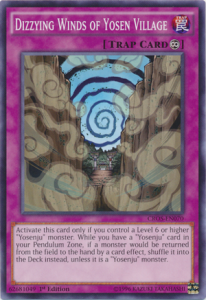 Then it all comes down to the Dizzying Winds. This card can be bananas for two very distinct reasons. 1: Spinning cards back to the deck is cool, especially now that we have a Spell Speed 2 double bouncer in the form of Yosenjus’ Sword Sting. 2: This card lets you reap all the benefits of the Shinchu, without needing to run more than one copy of the terrible Yosenju Shinchu R. Hitot 100% covers the niche that R used to cover, but we need to run at least 1 copy of R for Oroshi Channeling. What happens if you draw into the dreaded R? Well, just shuffle it back into the deck with Sabu’s second effect, setting your free Dizzying Winds. Is this a perfect solution? No, but it definitely helps out some.
Then it all comes down to the Dizzying Winds. This card can be bananas for two very distinct reasons. 1: Spinning cards back to the deck is cool, especially now that we have a Spell Speed 2 double bouncer in the form of Yosenjus’ Sword Sting. 2: This card lets you reap all the benefits of the Shinchu, without needing to run more than one copy of the terrible Yosenju Shinchu R. Hitot 100% covers the niche that R used to cover, but we need to run at least 1 copy of R for Oroshi Channeling. What happens if you draw into the dreaded R? Well, just shuffle it back into the deck with Sabu’s second effect, setting your free Dizzying Winds. Is this a perfect solution? No, but it definitely helps out some.
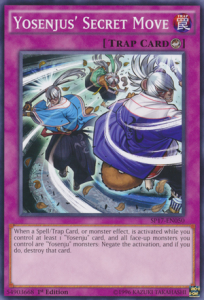 The last thing I really want to highlight about this strategy is its interactions with the opponent. Yosenjus’ Secret Move lets you negate cards/effects as long as you have a face-up Yosenju card (read Yosenju Pendulum Spell), and it isn’t a hard once per turn. The second was the other trap mentioned in the last paragraph – Yosenjus’ Sword Sting – with this you can bounce away an opponents monster setup. This is a perfect card in certain matchups, such as blowing away both of your opponent’s Orucst monsters after they prepare the normal Dingirsu setup. But wait – YOU GET MORE. Both of these traps are searchable by Kama 3 or Training Ground, and since you have so much draw power between both Pot of Extravagance, Yosenju Izna, and Card of Demise, you really do maximize your chance of seeing the traps come through.
The last thing I really want to highlight about this strategy is its interactions with the opponent. Yosenjus’ Secret Move lets you negate cards/effects as long as you have a face-up Yosenju card (read Yosenju Pendulum Spell), and it isn’t a hard once per turn. The second was the other trap mentioned in the last paragraph – Yosenjus’ Sword Sting – with this you can bounce away an opponents monster setup. This is a perfect card in certain matchups, such as blowing away both of your opponent’s Orucst monsters after they prepare the normal Dingirsu setup. But wait – YOU GET MORE. Both of these traps are searchable by Kama 3 or Training Ground, and since you have so much draw power between both Pot of Extravagance, Yosenju Izna, and Card of Demise, you really do maximize your chance of seeing the traps come through.
Alternative Techs:
Note the very small list of other techs – Yosenju really doesn’t play well with any other archetypes or cards that Special Summon, and WIND doesn’t have the greatest attribute support… this leads for a pretty lackluster tech section, outside of one key card I’ve held until this point to discuss further.
- Key Strategic Choice:
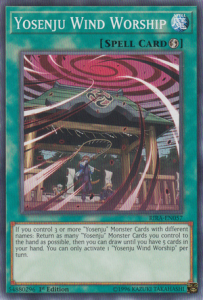 Yosenju Wind Worship: Easily the most debated card from the new set. At best a +1, this spell seems counterintuitive. But it does give the deck a couple of things and can be used to replace either the Extravagance (in which case you run an extra Demise) or you choose to replace the Card of Demise themselves with this. Since it specifies “Monster Cards”, this includes face-up Pendulum Spells. Thus, this is an in-theme way to dodge the destruction of your Shinchu by Oroshi Channeling after they are placed to your field. Secondly, this card is also an in-theme way to dodge Effect Veiler, Hot Red Dragon Archfiend Abyss, and Infinite Impermanence while using the Pendulum variant of the deck. If they try to stop your Kama 1,2,3’s extra Normal effect while you have 2 scales out, chain this card to return your cards to hand and keep summon chaining. This situation would only let you draw to replace the activation of Worship itself, but it does stop your plays from being interfered with, outside of just relying on an initial Pendulumed Daibak before going for your summon spam. Also, this card gets you out of Mine. Again, this is a pure strategic choice to make, but it definitely has significant benefits to consider. I’m just afraid too many people threw it immediately in the ‘bad’ pile without giving its strategic value a second thought.
Yosenju Wind Worship: Easily the most debated card from the new set. At best a +1, this spell seems counterintuitive. But it does give the deck a couple of things and can be used to replace either the Extravagance (in which case you run an extra Demise) or you choose to replace the Card of Demise themselves with this. Since it specifies “Monster Cards”, this includes face-up Pendulum Spells. Thus, this is an in-theme way to dodge the destruction of your Shinchu by Oroshi Channeling after they are placed to your field. Secondly, this card is also an in-theme way to dodge Effect Veiler, Hot Red Dragon Archfiend Abyss, and Infinite Impermanence while using the Pendulum variant of the deck. If they try to stop your Kama 1,2,3’s extra Normal effect while you have 2 scales out, chain this card to return your cards to hand and keep summon chaining. This situation would only let you draw to replace the activation of Worship itself, but it does stop your plays from being interfered with, outside of just relying on an initial Pendulumed Daibak before going for your summon spam. Also, this card gets you out of Mine. Again, this is a pure strategic choice to make, but it definitely has significant benefits to consider. I’m just afraid too many people threw it immediately in the ‘bad’ pile without giving its strategic value a second thought.
- Other Themed Tech Options:
- Yosenju Oyam: Offering the ability to protect your LP in a pinch as well as serving as an additional searcher can be cool. This card also interacts well with Stormforth, offering an alternative Tribute Summonable monster in a pinch to add at the end of your Yosenju Normal Summon train.
- Yosenju Tsujik: Yes, I panned this card earlier, but as much as I dislike using it, it is still an option. If you want that extra ATK you don’t need, feel free to use this.
- Yosenju Kodam and Foolish Burial: This card is a super unique case of “it’s great if I am losing, but I don’t need it if I am winning.” An extra Normal summon after your chain is disrupted can be a lifesaver, so make sure you think about whether or not you want to use this card for that reason alone. But this version of the deck does have Pendulum summoning already as its fallback…
- Other Support
- Pendulum Back: As a deck that aims to play a grind game until they can explode on their second turn with consistent access to two scales, this actually isn’t a bad option to give yourself a better grind game. But the biggest issue with Yosenju now is their initial play rather than their later ones.
- Divine Wind of Mist Valley: WIND monsters bouncing to hand? Free summons say yes please. This can work as just a way to guarantee you have a monster blocking your LP, but it does come at the cost of restricting you from activating your Sword Sting.
Addressing the Tech Elephant in the Room:
Lastly, I want to address the three meta-shifting cards released in the Gold Sarcophagus tins, generally but also in specific relation to Yosenju, as there seems to much misunderstanding as to which is appropriate for which strategies.
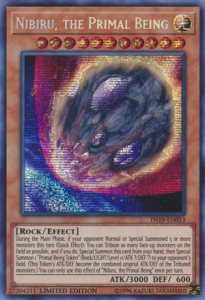 Nibiru, the Primal Being is an amazing card for creating some inherent doubt in playing a specific way. Much like Gorz in past incentivized attacking in specific orders, Nibiru incentivizes conservative play. The big downside to Nibiru is the token that it generates for the opponent, sometimes having immense stats. In terms of Yosenju, this strategy really doesn’t care too much about the token, as you can easily blow it right off the field. The bigger issue for this theme is that Nibiru summons itself to your field and is not a Yosenju monster. This immediately disables your Oroshi Channeling, your Secret Move, and your Sword Sting for a small disruption. Looking at it that way, it almost seems like you may be disrupting yourself more than your opponent by dropping Nibiru with this deck.
Nibiru, the Primal Being is an amazing card for creating some inherent doubt in playing a specific way. Much like Gorz in past incentivized attacking in specific orders, Nibiru incentivizes conservative play. The big downside to Nibiru is the token that it generates for the opponent, sometimes having immense stats. In terms of Yosenju, this strategy really doesn’t care too much about the token, as you can easily blow it right off the field. The bigger issue for this theme is that Nibiru summons itself to your field and is not a Yosenju monster. This immediately disables your Oroshi Channeling, your Secret Move, and your Sword Sting for a small disruption. Looking at it that way, it almost seems like you may be disrupting yourself more than your opponent by dropping Nibiru with this deck.
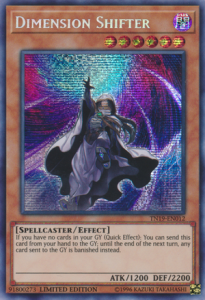 On the other hand, Dimension Shifter offers something the others do not – multi-turn protection. The turn it is activated, you are disrupting your opponent from effectively using their GY. The turn after, you are insulated from potential hand traps that require being sent to the GY. For a deck that doesn’t really utilize the Extra deck and thus most monsters do not go the GY, Shifter can be live later in the duel for Yosenju than for most other decks. The additional hand trap prevention, on top of Izna’s powerful protection effect, really does add an extra cherry on top. So this is definitely one of the better options to consider of the three, but there is still one more that seems to be made for Yosenju.
On the other hand, Dimension Shifter offers something the others do not – multi-turn protection. The turn it is activated, you are disrupting your opponent from effectively using their GY. The turn after, you are insulated from potential hand traps that require being sent to the GY. For a deck that doesn’t really utilize the Extra deck and thus most monsters do not go the GY, Shifter can be live later in the duel for Yosenju than for most other decks. The additional hand trap prevention, on top of Izna’s powerful protection effect, really does add an extra cherry on top. So this is definitely one of the better options to consider of the three, but there is still one more that seems to be made for Yosenju.
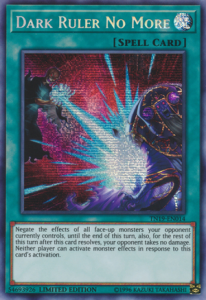 Dark Ruler No More is one of the weirdest spells in the game. On paper, it seems ridiculously strong, being able to shut off your opponent’s monsters for an entire turn. This is great for the recent trend in the game to spam ‘unbreakable’ monster boards, but there is one unmentioned requirement for running this spell – you need to be running a strategy that can consistently break an established board once Dark Ruler is activated. Yosenju is a textbook example of an archetype that is able to do just that. You can easily rely upon your Pendulum overlords to blow your opponent’s established field, with a blast off into the distance, plus you have your Kama 1 to clean up with additional bouncing duties. Also, since this archetype is designed to be able to survive ‘open boards’ after all of your pseudo-spirits return to hand, you should have the tools to disrupt your opponent from fully bouncing back into the duel, now that you had a turn to establish your own disruption options.
Dark Ruler No More is one of the weirdest spells in the game. On paper, it seems ridiculously strong, being able to shut off your opponent’s monsters for an entire turn. This is great for the recent trend in the game to spam ‘unbreakable’ monster boards, but there is one unmentioned requirement for running this spell – you need to be running a strategy that can consistently break an established board once Dark Ruler is activated. Yosenju is a textbook example of an archetype that is able to do just that. You can easily rely upon your Pendulum overlords to blow your opponent’s established field, with a blast off into the distance, plus you have your Kama 1 to clean up with additional bouncing duties. Also, since this archetype is designed to be able to survive ‘open boards’ after all of your pseudo-spirits return to hand, you should have the tools to disrupt your opponent from fully bouncing back into the duel, now that you had a turn to establish your own disruption options.
At the end of the day, each of these three cards really are game-warping. For a quick wrap-up, Nibiru isn’t great, Shifter provides protection against two turns, and Ruler gives you an easy out to monster-heavy boards. While I don’t run any of these in the main deck, you could switch out The Monarchs Stormforth with 3 copies of the disruptor of your choice, at which point it is almost required that you switch out your Magat for Oyam or another high leveled Yosenju to search with Oroshi Channeling if you don’t want a Pendulum.
Conclusion:
Yosenju has gusty gutsy plays that truly make for whirlwind duels. With the Pendulum monsters finally being folded back into the strategy, this deck might finally be able to exhibit its true power with both sides of the archetype holding its own. If you prefer to stick with the slower way to play, that’s a complete option. But this article hopefully showed you just how much spirit this WIND theme has behind its punches. Thanks for reading, and catch you next time! Or should I say ensnare you in some Drosophyllum lusitanicum.
Reminder, I also take suggestions for future CDS articles! I really want to see some input from you! Fun fact, this article was specifically requested by a reader through Discord! If you wish to see a CDS article about the archetype, theme, or strategy you love, feel free to private message me on the YGOrg Discord server, the YGOrganization Forums, or just post a comment in response to this article on our Facebook page with your ideas to keep under consideration. On most YGO-related communities my username is Quincymccoy, so feel free to reach out.

